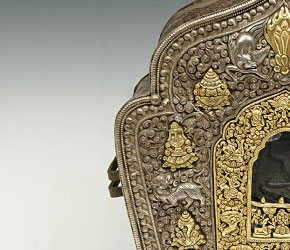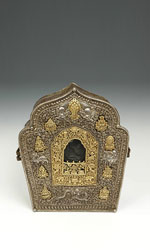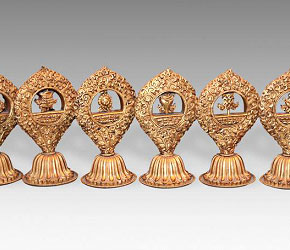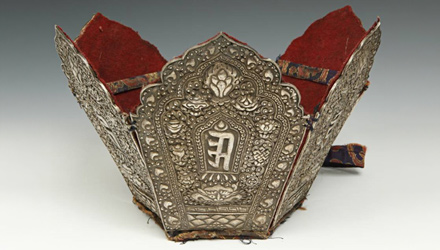Ashtamangala or Eight Auspicious Symbols
 |
|
Part of the Primitive Collection – Tibetan, Buddhist, and Himalayan art (detail) |
From the early days of religion in
One important group consists of eight symbols called the
The following are the Eight Symbols of Good Fortune:
1) The Parasol
2) The Golden Fishes
3) The Treasure Vase
4) The Lotus
5) The Right-Turning Conch Shell
6) The Glorious Endless Knot
7) The Victory Sign
8) The Wheel
The Parasol (In Tibetan, gdugs; in Sanskrit, chattra)
 |
|
The significance of a parasol as a protective symbol is not too mysterious considering the ability to protect oneself against inclement weather has always, in all cultures, been important, and in many cases, elevated to a status symbol. In fact, even in Europe until a few decades ago, a sunshade was a status symbol for society ladies. A few thousand years ago in a country like India, anyone who owned such a luxury object was certainly one of the well-to-do; and if, in addition, one had servants who carried the parasol, then indeed one’s rank and wealth were made very clearly manifest. The development of the meaning of the parasol as a symbol of power or of royal rank is nonetheless lost in antiquity. The fact that it protected the bearer from the heat of the sun was transferred into the religious sphere as “protection against the heat of the defilements,” known as nyon-mongs in Tibetan and klesa in Sanskrit.
The Tibetans adopted the parasol from Indian art. Within the Eight Symbols, the parasol stands as a sign of spiritual power in a positive sense; the meaning of the symbol is transferred from the worldly to the spiritual level.
The Golden Fishes (In Tibetan, gser-nya; in Sanskrit, suvarnamatsya)
This symbol consists of two fishes, which usually appear vertically, parallel or slightly crossed, and heads down and turned towards each other. Originally, in India, the fish represented the sacred Ganges and Yamuna rivers. As early as the second or third century A.D., they were put on clay vessels as symbols of good fortune, ultimately finding their way into the traditions of Jainism and Buddhism. In Tibet, they became incorporated as one of the Ashtamangala.
The Treasure Vase (In Tibetan, gter-chen-po’i bum-pa; in Sanskrit, kalasa)
 |
|
The vase is a fat-bellied vessel with a short, slim neck. The upper opening is formed by a turned-down, broad, decorated rim. The base is a round stand and also decorated. On top, at the opening, there is a large jewel which indicates that it is a treasure vase.
In regard to the general meaning of the treasure vase: on the physical level, it is believed the symbolic meaning was derived from the idea of storage and the satisfaction of material desires. In numerous cultures the idea of the inexhaustible vessel is found. For example, Hotei, the Laughing Buddha with the large belly, carries an inexhaustible sack of treasures. However, on the spiritual level the vase is often associated with the possession of supernormal abilities. The special form of the treasure vase seen among the
The Lotus (In Tibetan, padma; in Sanskrit, padma)
The lotus does not grow in Tibet, so Tibetan art has only stylized versions, which vary greatly from Japanese or Indian depictions, for example. In the Eight Symbols, a basic form is employed, and when shown in color depicts a white flower with slight reddish shedding, with or without a stem.
The lotus is altogether one of the best-known symbols. It is considered to be a symbol of purity, especially mental purity. Although it has its roots in the mud of ponds and lakes, its flower is raised in immaculate beauty above the surface of the water. Only the lotus, owing to the strength of its stem, regularly rises eight to twelve inches above the surface.
The Right-Turning Conch Shell (In Tibetan, dung g.yas-‘khyil; in Sanskrit, daksinavartasankha)
The conch is a white shell of good size, spiral and oval with pointed ends. The right-turning (clockwise-spiraling) form is considerably rarer than the left turning form, and is therefore considered more valuable. As a natural object, not made with human hands, it is one of the oldest ritual objects and is often referred to as a sea or snail shell. The Tibetan term dung covers both.
In Tibetan Buddhism, the conch is particularly valued for its powerful sound as an instrument. Consequently, it is also referred to as a trumpet. Conch trumpets are used to call together assemblies and as a container for saffron water. They also serve as ornaments for decorating thrones and as attributes on statues.
Among the Ashtamangala, the conch stands for the fame of the Buddha’s teaching, which spreads in all directions like its sound. Thus, the conch has a deep religious significance.
The Glorious Endless Knot (In Tibetan, dpal be’u; in Sanskrit, srivatsa)
The endless knot is a closed, graphic ornament composed of right-angled, intertwined lines. In its earliest form, it appears as a “naga symbol” with two stylized snakes. Ultimately, it evolved into the endless knot, which has also been described as the “love knot.” For Tibetans, the intertwining of the lines depicts how all phenomena are intertwined and dependent on causes and conditions. The knot is comprised of a pattern with no gaps or breaks, which at once expresses motion and rest in a representational form of great simplicity and fully balanced harmony. The endless knot is one of the favorite symbols in Tibetan culture. Although it is one of the Ashtamangala it also appears quite frequently on its own. It is conceived as being auspicious in the highest degree, and its “mode of operation” is always experienced at many levels. Since all phenomena are interrelated, the placing of the endless knot on a gift or on a greeting card is understood to establish an auspicious connection between the giver and the recipient. At the same time, the recipient is supposed to be linked up with favorable circumstances in the future, reminded that future positive effects have their roots in the causes of the present, which is what karma is all about.
Since the knot has no beginning and no end, it also symbolizes the infinite knowledge of the Buddha.
The Victory Sign (In Tibetan, rgyalan; in Sanskrit, dhvaja)
The Victory Sign symbolizes the victory of knowledge over ignorance or the victory over all hindrances; in other words, the attainment of happiness. It incorporates the wish to bring about permanent, enduring happiness – both of the transient, worldly kind and of the ultimate kind – in the sense of tendrel, which means ”the interrelated nature of reality” or ”interdependent origination”
Like the love knot, this sign is also seen apart from the Eight Symbols; for example, as adornment on temple roofs and the roofs of private houses where there was a complete set of the canonical texts, and the texts themselves, known as the Kangyur. The victory sign can serve as a hanging ornament in temples, as the finial of the long prayer-flag masts (dar-chen), and as an attribute of certain deities, such as Vaisravana, the guardian of wealth.
The Chakra Wheel (In Tibetan, ‘khor-lo; in Sanskrit, cakra)
The wheel consists of a hub, rim, and generally eight spokes, although sometimes more are depicted. The circle as its underlying form is a universal symbol found in all cultures. In pre-Buddhist India it was a symbol for the sun. The number of spokes varied according to tradition – six, eight, twelve, thirty-two, or one thousand. These were equated with motion, while the rim represented limitation. The hub was interpreted as the axis of the world. The wheel was used as an emblem or attribute of Hindu deities, although the meaning was changed in Buddhist culture.
The most well known form of the wheel belongs to the Eight Symbols. It is interpreted as the wheel of Dharma, which the Buddha set in motion with his first discourse. Accordingly, in Buddhism, there are various explanations of its significance. One of these explanations makes reference to the three trainings of Buddhist practice: the hub stands for the training in moral discipline, through which the mind is supported and stabilized; the spokes stand for the application of wisdom in regard to emptiness, which cuts off ignorance; and the rim denotes training in concentration, which holds the practice together.
Within the Ashtamangala the wheel symbolizes the
 |
|
Download this Article: Ashtamangala.pdf